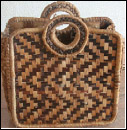 Art
and Literature Art
and Literature |
Rwandans produce many beautiful crafts. Women weave
baskets and mats from banana leaves, grasses and
papyrus fibres. Geometrical designs, usually in
black, white and red, are often woven into these
objects. It is considered a sign of wealth and status
to own many decorated baskets and mats. In addition
to these objects, women make practical items from
banana leaves, such as pot holders and the coils
that they put on their heads to support burdens.
Men do woodcarving and make drums, pipes for smoking,
stools, knife handles, bowls and jugs.
Many traditional musical instruments are played
in Rwanda. Stringed instruments such as the lulunga
(an eight-stringed instrument similar to a harp)
accompany singing and dancing. The mbira or kalimba
is a thumb-piano. Flutes are made from reeds. Drums
are very important in Rwandan music and drummers
often play in groups of seven to nine. The drums
are of different sizes and each produces a distinct
tone. Together, the drummers produce a complex rhythm.
|

Rwanda also has a rich tradition of stories and
folklore. Storytelling and public speaking are much
admired and good storytellers are honoured. Many
stories have a message and were once used to teach
values such as cooperation or generosity. Other
stories tell of the exploits of heroes or the suffering
caused by evil spirits.
Very little literature has been written in Kinyarwanda,
but a number of authors have written books in French.
Alexis Kagame (1912-81) was a clergyman, historian,
ethnologist and philosopher who researched the oral
history of Rwanda and published several volumes
of poetry and Rwandan mythology. J. Saverio Naigiziki
wrote an autobiography, Escapade rwandaise (Rwandan
Adventure) and a novel, L'Optimiste (The Optimist),
about the marriage of a Hutu man and a Tutsi woman.
Yollande Mukagasana, a Rwandan writer who survived
the genocide and now lives in Europe, has written
two books, La mort ne veut pas de moi (Death Doesn't
Want Me) and N'aie pas peur de savoir (Don't Be
Afraid to Know), about her experiences. |

